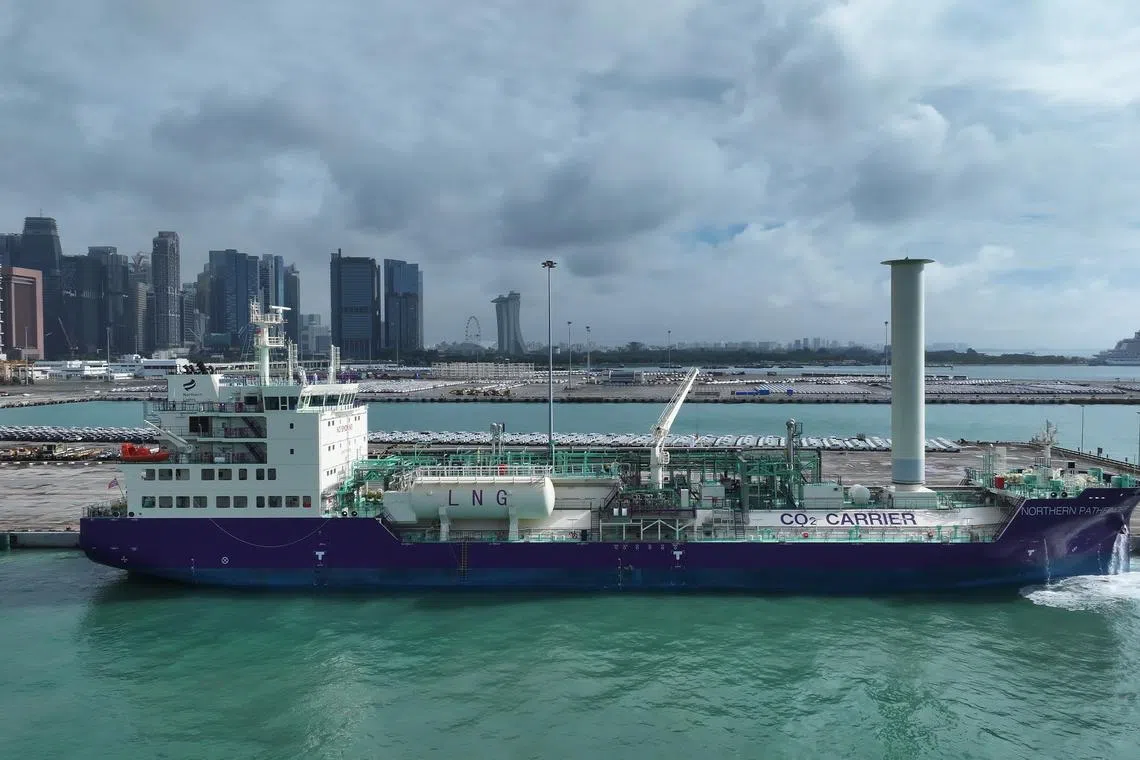Norwegian CO2 carrier ship in S’pore offers glimpse of future carbon capture in region
Sign up now: Get ST's newsletters delivered to your inbox

The Northern Pathfinder is part of the world’s first cross-border carbon capture and storage project, called Northern Lights.
PHOTO: SHELL
Follow topic:
SINGAPORE – A purple and turquoise vessel that docked at Tanjong Pagar Terminal on Jan 16 and 17 drew attention not just for its unique colours.
Deep in the belly of the 130m-long Northern Pathfinder are two tanks that can hold about 8,000 tonnes in total of planet-warming liquid carbon dioxide (CO2).
Built in a China shipyard, the vessel is on its maiden voyage to Norway, where an interim storage facility is waiting to receive the CO2 before the liquid is sent to a vault kilometres beneath the North Sea seabed.
The Northern Pathfinder, powered by liquefied natural gas and which had been refuelled in Singapore, is part of the world’s first cross-border carbon capture and storage (CCS) project, called Northern Lights.
The project – jointly formed by energy and oil and gas giants Shell, TotalEnergies and Equinor – aims to contribute to a commercial CCS market in Europe.
Northern Pathfinder offers a glimpse of the infrastructure needed to shape CCS projects in South-east Asia and the Asia-Pacific.
On Jan 17, the media, industry partners and representatives from Singapore agencies, among others, were invited to tour the ship.
Shell is the lead developer of the vessel – one of four ships that will form a fleet of CO2 carriers under the project.
Northern Pathfinder’s sister ship, Northern Pioneer, left China for Norway in November 2024.
Transporting captured CO2 from emitter countries to storage nations using ships is key for the region’s CCS ambitions, said Ms Zharin Zhafrael Mohd, Shell’s general manager of CCS for the Asia-Pacific.
“(The Asia-Pacific)... is largely archipelago, so shipping becomes absolutely imperative and important for us to realise carbon capture and storage, and reduce carbon emissions,” she added at a media briefing on Jan 17.
Mr Lee Teng-Huar, Shell’s general manager for maritime operations for the Asia-Pacific and Middle East, said: “Compared with a pipeline which is fixed between two parties, point to point, shipping allows you to be a lot more flexible.
“If the project grows a lot more scalable, it can always increase more ships to take on more volumes, versus a pipeline where, once it’s built, capacity could be limited.”
Shell, which has formed a consortium with ExxonMobil and is partnering the Singapore Government, has been evaluating the technical and economic feasibility of cross-border carbon capture projects here, since the Republic lacks suitable and sizeable geological storage sites.

The Northern Pathfinder offers a glimpse of the infrastructure needed to shape carbon capture and storage projects in South-east Asia and the Asia-Pacific.
PHOTO: SHELL
The consortium plans to develop a CCS project that can permanently store 2,500 kilotonnes of CO2 a year by 2030, either in rock formations deep underground or under the seabed, given that the region has strong geological potential for CO2 storage.
On storage locations, Shell has been looking at places like Brunei, Malaysia, China and Australia.
The National Climate Change Secretariat has said that early CCS projects will target highly concentrated CO2 emissions from energy or chemical plants on Jurong Island.
Sectors such as chemicals produce CO2 as part of their production processes, and will require the use of CCS to avoid releasing new emissions into the atmosphere.
Singapore now levies a carbon tax of $25 per tonne, with a view of reaching $50 to $80 per tonne by 2030.
In early January, it was announced that Singapore and Malaysia will discuss cross-border CCS
Singapore is also looking to collaborate with Indonesia, which has passed a law to allow CCS operators to set aside storage capacity for international entities.
The Republic also aspires to become a hub for the trading of carbon credits.
In June 2024, delegates from Singapore, including Senior Minister of State for Sustainability and the Environment and Transport Amy Khor, visited the Northern Lights project’s receiving terminal in Oygarden in western Norway.
The Northern Lights team, local consortium and government representatives have had multiple engagements centred on the technical risks and complexities of CCS, transboundary agreements and the commerciality of the solution, said Ms Zharin.
CCS is highly expensive because it is a nascent technology, and the cost for each project varies depending on the type of capture method, mode of transport and storage location.
A project like Northern Lights costs about US$1 billion (S$1.37 billion) or US$2 billion, added Ms Zharin. “So it’s a very strong public-private partnership where the Norwegian government takes the lead, where the funding of about 80 per cent of the capital expenditure was supported.”
The Northern Pathfinder is currently en route to Norway, with the trip expected to take more than 40 days. After joining its sister ship in Norway, it will undergo testing.
One ship will be in Oygarden and the other in Brevik, where the first operational customer, building materials giant Heidelberg Materials, is located.

The first phase of the CCS project, where 1.5 million tonnes of liquid CO2, equivalent to the emissions of 750,000 cars in one year, will be annually injected into an undersea reservoir 2.6km under the North Sea seabed, has been fully booked by customers.
They include Heidelberg, an ammonia and fertiliser producer in the Netherlands, and a Danish energy company.
Northern Lights will transport and store 400,000 tonnes of CO2 from Heidelberg every year.
Operations are scheduled to start in 2025, but a date has not been revealed.
Shabana Begum is a correspondent, with a focus on environment and science, at The Straits Times.



